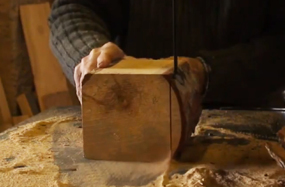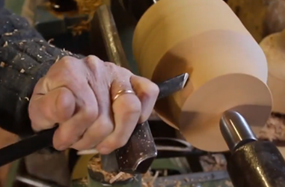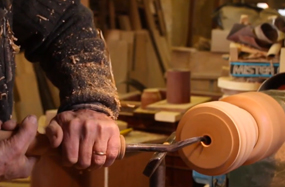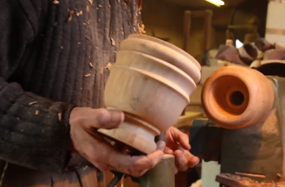The production stages of wood turning
The best time to cut a tree is during the winter, when the moon is waning. The wood is driest during this period, ideally during the months of December or January.
Cutting the wood |
|
|
Turning the wood |
|
The turning of a salt pestle
Drilling
|
The drilling process consists of boring holes of various dimensions into the worked wood. |
|
|
|
||
Finishing and Painting
|
Waxing
Buffing with wax calls for the application of a beeswax paste, applied on a background prepared with French polish, which can be spread along the object with a paintbrush or a polishing pad. The object of this polishing process is to close the wood’s pores and create a suitable backdrop on which the wax will be spread. Once the polish is dry, the artisan passes a very fine steel wool cloth over the surface of the product to make sure that its surface is uniformly opaque and smooth. The polish can be reapplied many times, after which the wax will be applied over the entire surface. Once it is dried, a warm wool cloth is used to buff the whole object. Each of these tasks is done by hand without the assistance of other equipment or machines. Linseed Oil Baked linseed oil is ideal for finishing, often used in place of varnishes, whether for indoor or outdoor wood. The distinctive trait of this oil is that it seeps into all open pores in the wood’s cellular structure, making it completely impermeable. Furthermore, finishing with baked linseed oil not only covers the treated wood surface like a varnish, but also penetrates the wood, lending it a shiny yet not plastic effect while leaving its beautiful natural grain visible. Staining Varnish is applied with a brush or a sponge passed along the wood in parallel lines. Varnish Transparent varnish enhances the appearance of the wood’s grain. After intensive sanding, it usually helps to add a preventive coat of wood filler. The varnish can be colorless or etched. This process is carried out with an electric spray gun that allows for a very subtle uniform application of the varnish, and it is important to monitor possible leakage. Flatting This is a synthetic varnish that is applied to the wood with a flat brush in slow, regular parallel strokes along the grain. When the first coat is dry, a second is applied. Water-Based Enamels These varnishes are of a very high quality. The primary advantage of water-based varnishes is that they do not carry the risk of unwanted stains because all containers and brushes can be cleaned easily with just water. |
- Top of page -




